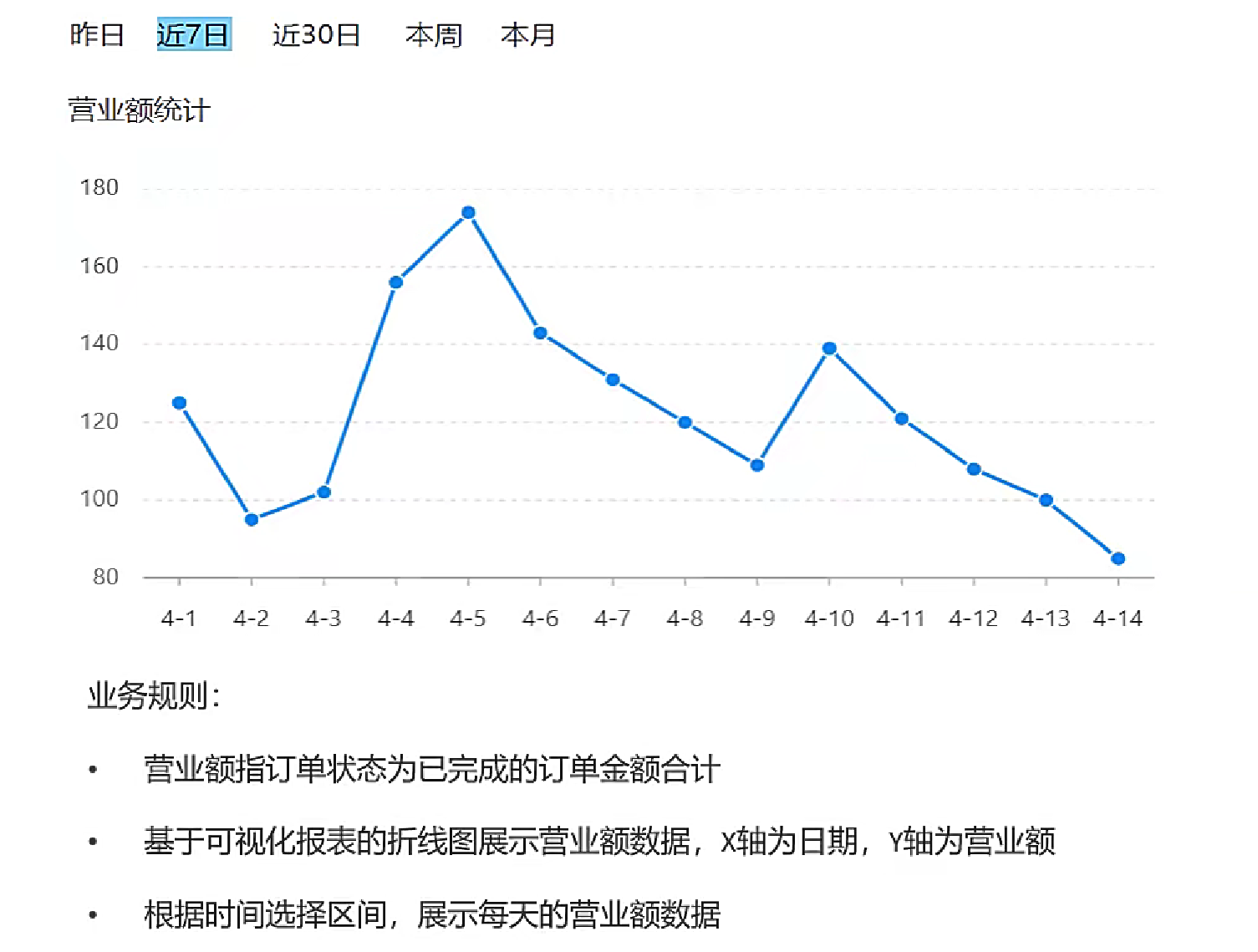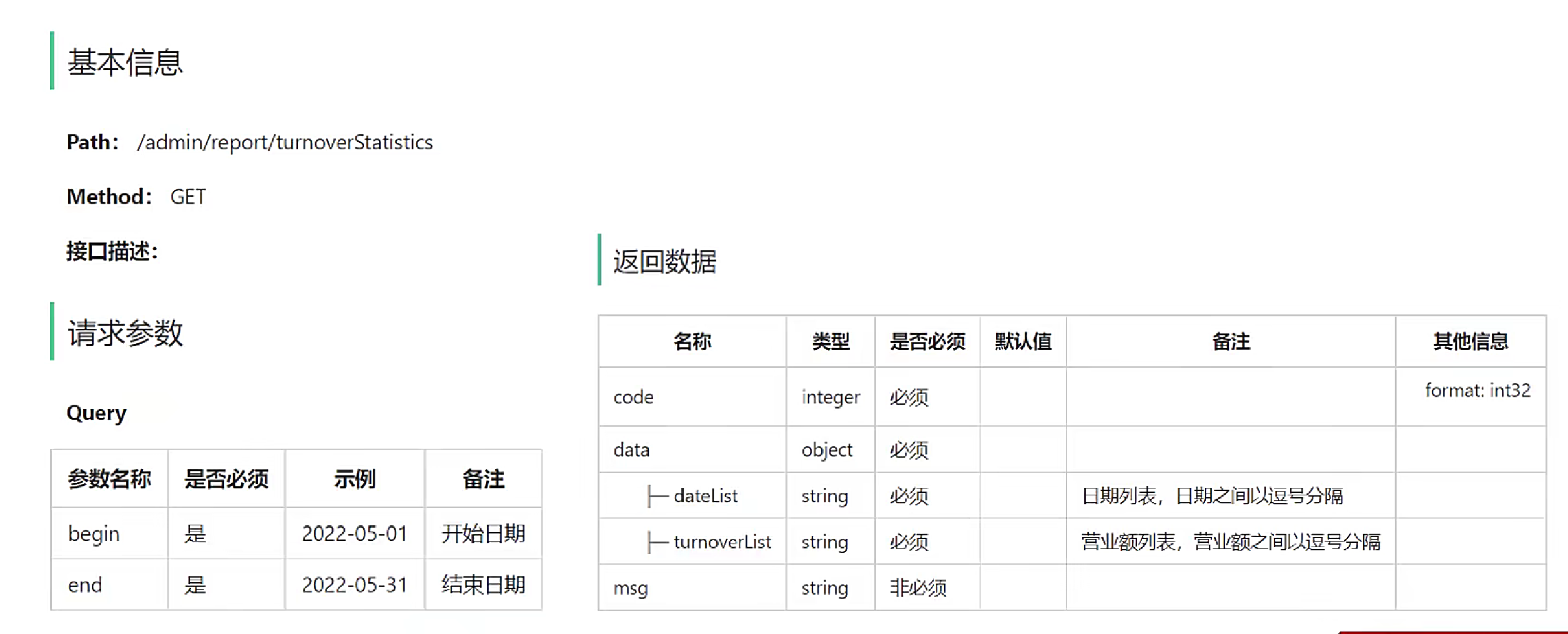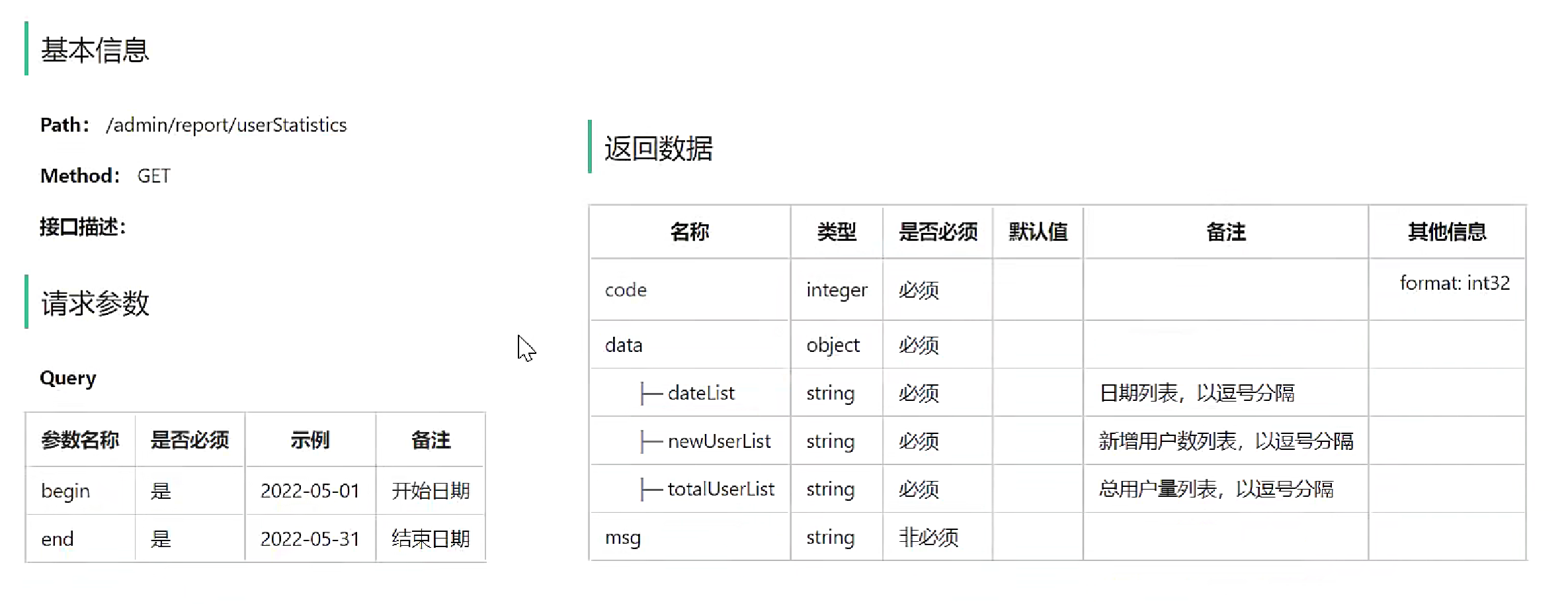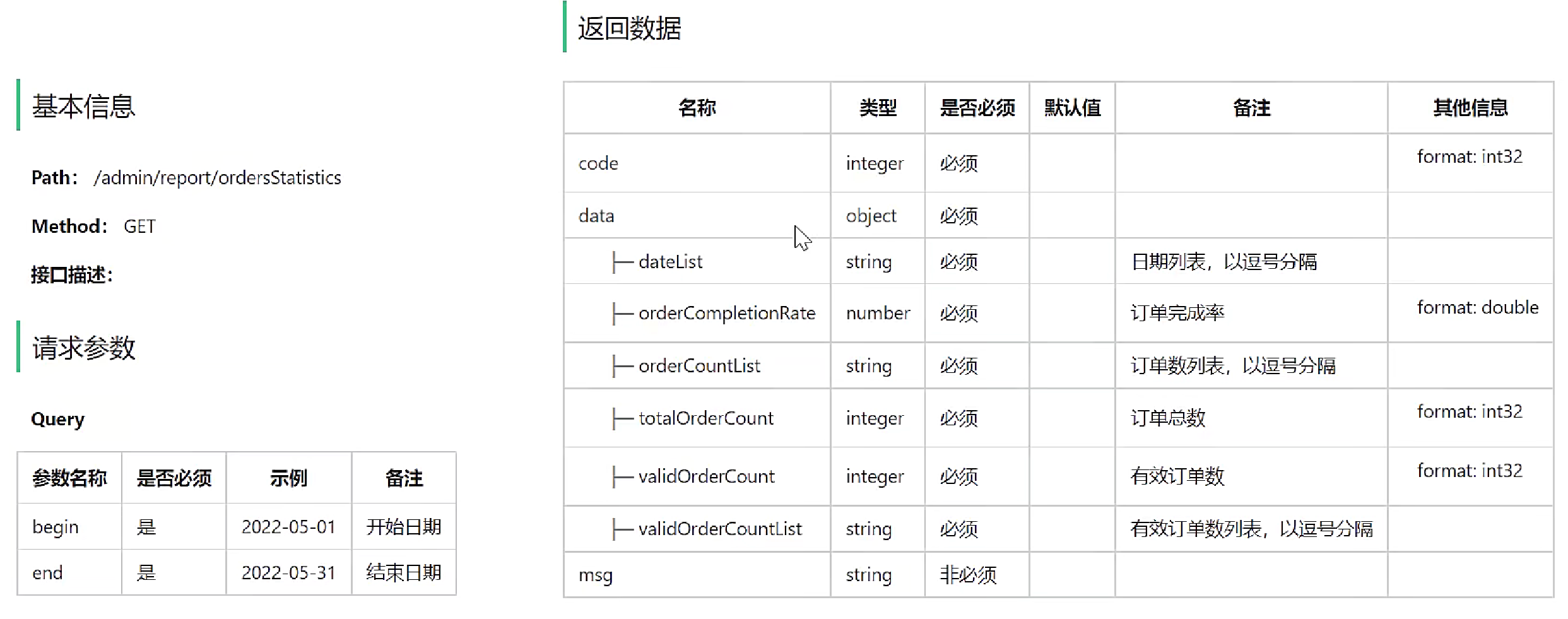D10
数据统计图形报表
这里借助Apache Echarts,一个前端数据可视化平台

营业额统计

表现层
设置传入数据格式
@RestController
@Api("数据相关统计接口")
@RequestMapping("/admin/report")
@Slf4j
public class ReportController {
@Autowired
private ReportService reportService;
@GetMapping("/turnoverStatistics")
@ApiOperation("营业额统计")
public Result<TurnoverReportVO> turnoverStatistics(
@DateTimeFormat(pattern = "yyyy-MM-dd") LocalDate begin,
@DateTimeFormat(pattern = "yyyy-MM-dd") LocalDate end
){
log.info("营业额统计:{},{}",begin, end);
TurnoverReportVO turnoverStatistics = reportService.getTurnoverStatistics(begin, end);
return Result.success(turnoverStatistics);
}
}
实现类
将指定时间段内的日期放到List中,遍历日期,对每天进行查询营业额
@Service
@Slf4j
public class ReportServiceImpl implements ReportService {
@Autowired
private OrderMapper orderMapper;
/**
* 统计指定时间区间内的营业额数据
* @param begin
* @param end
* @return
*/
public TurnoverReportVO getTurnoverStatistics(LocalDate begin, LocalDate end) {
//当前集合用于存放从begin到end范围内的每天的日期
List<LocalDate> dateList = new ArrayList<>();
dateList.add(begin);
while(!begin.equals(end)){
//日期计算,计算指定日期的后一天对应的日期
begin = begin.plusDays(1);
dateList.add(begin);
}
List<Double> turnoverList = new ArrayList<>();
for (LocalDate date : dateList) {
//查询date日期对应的营业额数据,营业额是指,状态为“已完成”的订单金额合计
LocalDateTime beginTime = LocalDateTime.of(date, LocalTime.MIN);//表示某天的00:00
LocalDateTime endTime = LocalDateTime.of(date, LocalTime.MAX);
// select * from order where status = ? and order_time > beginTime and orderTime < endTime
Map map = new HashMap();
map.put("begin", beginTime);
map.put("end", endTime);
map.put("status", Orders.COMPLETED);
Double turnover = orderMapper.sumByMap(map);
turnover = turnover == null ? 0.0 : turnover;
turnoverList.add(turnover);
}
//封装返回结果
return TurnoverReportVO
.builder()
.dateList(StringUtils.join(dateList,","))
.turnoverList(StringUtils.join(turnoverList, ","))
.build();
}
}
映射文件
<select id="sumByMap" resultType="java.lang.Double">
select sum(amount) from orders
<where>
<if test="begin != null">
and order_time > #{begin}
</if>
<if test="end != null">
and order_time < #{end}
</if>
<if test="status != null">
and status = #{status}
</if>
</where>
</select>
用户统计

表现层
/**
* 用户统计
* @param begin
* @param end
* @return
*/
@GetMapping("/userStatistics")
@ApiOperation("用户统计")
public Result<UserReportVO> userStatistics(
@DateTimeFormat(pattern = "yyyy-MM-dd") LocalDate begin,
@DateTimeFormat(pattern = "yyyy-MM-dd") LocalDate end
){
log.info("用户数据统计:{}, {}", begin, end);
return Result.success(reportService.getUserStatistics(begin, end));
}
实现类
这块重点是动态SQL的编写,查询用户数量主要涉及select count from user where create_time > ? and create_time < ?,问号处分别为一天的起始时间和结束时间。
比如:
如果是查询新增用户,那么问号处不为空,表示在某天新增的注册用户。
如果是查询用户总数,只需要endTime,表示查询在这之前的所有用户。
/**
* 统计指定时间内的用户数据
* @param begin
* @param end
* @return
*/
public UserReportVO getUserStatistics(LocalDate begin, LocalDate end) {
//当前集合用于存放从begin到end的范围的每天日期
List<LocalDate> dateList = new ArrayList<>();
while(!begin.equals(end)){
begin = begin.plusDays(1);
dateList.add(begin);
}
// 存放每天的新增用户 select count(id) from user where create_time > ? and create_time < ?
List<Integer> newUserList = new ArrayList<>();
// 存放每天的总用户数量 select count(id) from user where create_time < ?
List<Integer> totalUserList = new ArrayList<>();
for (LocalDate date : dateList) {
LocalDateTime beginTime = LocalDateTime.of(date, LocalTime.MIN);
LocalDateTime endTime = LocalDateTime.of(date, LocalTime.MAX);
Map map = new HashMap();
map.put("end", endTime);
//计算每天的总用户数量
Integer userTotal = userMapper.countByMap(map);
//计算每天的新增用户数量
map.put("begin", beginTime);
Integer newUser = userMapper.countByMap(map);
newUserList.add(newUser);
totalUserList.add(userTotal);
}
//封装结果数据
return UserReportVO.builder()
.dateList(StringUtils.join(dateList, ","))
.newUserList(StringUtils.join(newUserList, ","))
.totalUserList(StringUtils.join(totalUserList, ","))
.build();
}
<select id="countByMap" resultType="java.lang.Integer">
select count(id) from user
<where>
<if test="begin != null">
and create_time > #{begin}
</if>
<if test="end != null">
and create_time < #{end}
</if>
</where>
</select>
订单统计

表现层
/**
* 订单数据统计
* @param begin
* @param end
* @return
*/
@GetMapping("/ordersStatistics")
@ApiOperation("订单数据统计")
public Result<OrderReportVO> ordersStatistics(
@DateTimeFormat(pattern = "yyyy-MM-dd") LocalDate begin,
@DateTimeFormat(pattern = "yyyy-MM-dd") LocalDate end
){
log.info("订单数据统计:{}, {}", begin, end);
return Result.success(reportService.getOrderStatistics(begin, end));
}
实现类
实现类代码比较长,因为本业务要求返回orderReportVo对象,具有6个属性,具体实现见如下注释,总的来说这三类业务逻辑实现是相近的。
/**
* 统计指定时间内的订单数据统计
* @param begin
* @param end
* @return
*/
public OrderReportVO getOrderStatistics(LocalDate begin, LocalDate end) {
// 获取当前时间段所有日期
List<LocalDate> dateList = new ArrayList<>();
dateList.add(begin);
while(!begin.equals(end)){
begin = begin.plusDays(1);
dateList.add(begin);
}
//存放每天的订单数
List<Integer> orderCountList = new ArrayList<>();
//存放每天的有效订单数
List<Integer> validOrderCountList = new ArrayList<>();
//遍历datelist,查询每天的订单数和有效订单数
for (LocalDate date : dateList) {
LocalDateTime beginTime = LocalDateTime.of(date, LocalTime.MIN);
LocalDateTime endTime = LocalDateTime.of(date, LocalTime.MAX);
//查询每天的订单总数 select count(id) from orders where order_time > ? and order_time < ?
Map map = new HashMap();
map.put("begin", beginTime);
map.put("end", endTime);
Integer orderCount = orderMapper.countByOrders(map);
//查询每天有效订单数 select count(id) from orders where order_time > ? and order_time < ? and status = 5
map.put("status", Orders.COMPLETED);
Integer validOrderCount = orderMapper.countByOrders(map);
orderCountList.add(orderCount);
validOrderCountList.add(validOrderCount);
}
//计算时间区间内的订单总数量
Integer totalOrderCount = orderCountList.stream().reduce(Integer::sum).get();
//计算时间区间内的有效订单数量
Integer validOrderCount = validOrderCountList.stream().reduce(Integer::sum).get();
//计算订单完成率
Double orderCompletionRate = 0.0;
if(totalOrderCount != 0){
orderCompletionRate = validOrderCount.doubleValue() / totalOrderCount;
}
return OrderReportVO.builder()
.dateList(StringUtils.join(dateList, ","))
.validOrderCountList(StringUtils.join(validOrderCountList, ","))
.orderCountList(StringUtils.join(orderCountList, ","))
.validOrderCount(validOrderCount)
.orderCompletionRate(orderCompletionRate)
.totalOrderCount(totalOrderCount)
.build();
}
销量排名统计
需求分析

表现层
/**
* 销量排名top10
* @param begin
* @param end
* @return
*/
@GetMapping("/top10")
@ApiOperation("销量排名top10")
public Result<SalesTop10ReportVO> top10(
@DateTimeFormat(pattern = "yyyy-MM-dd") LocalDate begin,
@DateTimeFormat(pattern = "yyyy-MM-dd") LocalDate end
){
log.info("销量排名top10:{}, {}", begin, end);
return Result.success(reportService.getSalesTop10(begin, end));
}
实现类
因为涉及多表查询,所以这部分SQL会略显复杂,但整体功能实现还是比较简单的,要注意这里的stream流的用法,需要保持熟悉。
/**
* 统计指定时间内的销量排名前10
* @param begin
* @param end
* @return
*/
public SalesTop10ReportVO getSalesTop10(LocalDate begin, LocalDate end) {
// select od.name, sum(od.number) number from order_detail od, orders o
// where od.order_id = o.id and o.status = 5 and order_time > ? and order_time < ?
// group by od.name
// order by number desc
// limit 0,10
LocalDateTime beginTime = LocalDateTime.of(begin, LocalTime.MIN);
LocalDateTime endTime = LocalDateTime.of(begin, LocalTime.MAX);
List<GoodsSalesDTO> salesTop10 = orderMapper.getSalesTop10(beginTime, endTime);
List<String> names = salesTop10.stream().map(GoodsSalesDTO::getName).collect(Collectors.toList());
String nameList = StringUtils.join(names, ",");
List<String> number = salesTop10.stream().map(GoodsSalesDTO::getName).collect(Collectors.toList());
String numberList = StringUtils.join(number, ",");
//封装返回结果
return SalesTop10ReportVO.builder()
.nameList(nameList)
.numberList(numberList)
.build();
}
<select id="getSalesTop10" resultType="com.sky.dto.GoodsSalesDTO">
select od.name, sum(od.number) number from order_detail od, orders o
where od.order_id = o.id and o.status = 5
<if test="begin != null">
and order_time > #{begin}
</if>
<if test="end != null">
and order_time < #{end}
</if>
group by od.name
order by number desc
limit 0,10
</select>























 975
975

 被折叠的 条评论
为什么被折叠?
被折叠的 条评论
为什么被折叠?








